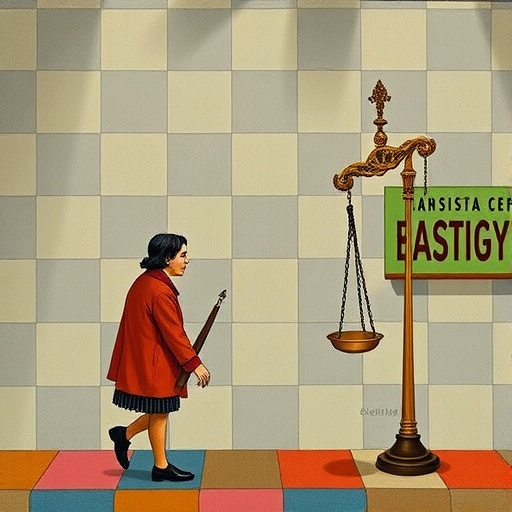In a groundbreaking study published in “J Autism Dev Disord,” researchers Kernahan, Weber, and Lim delve into a topic that has profound implications for the criminal justice system—the understanding of wrongfulness by autistic individuals. As society continues to grapple with the complexities of autism spectrum disorder (ASD), this research shines a light on the often overlooked and critically important nuances in how individuals with ASD perceive moral and legal norms.
The research emerges at a pivotal moment when public awareness and discourse around ASD are growing, yet there remains a significant gap in understanding how these individuals navigate sophisticated legal frameworks. Autistic individuals often face unique challenges when involved in criminal cases, particularly because traditional interpretations of consent, culpability, and ethical understanding may not apply seamlessly to them. The complexities of their cognitive processing can lead to misunderstandings and misinterpretations of actions deemed criminal under the law.
Central to this study is the premise that many autistic individuals experience a disconnect in recognizing societal norms around right and wrong, which can impact their behavior in situations that lead to legal scrutiny. The researchers conducted extensive interviews and comparative analyses to unravel these intricacies, aiming to highlight the diversity of thought processes among those on the spectrum, as well as common misconceptions held by law enforcement and judicial practitioners.
The findings of this study will serve not only to inform legal professionals but also to promote a broader understanding of the implications for how these individuals are treated within the judicial system. Traditional concepts of accountability and responsibility could lead to unjust outcomes if the underlying cognitive and perceptual differences of autistic individuals are not taken into account. Kernahan, Weber, and Lim advocate for a more informed approach, suggesting that training for law enforcement and legal entities is essential to ensure a fairer treatment of this demographic.
An important aspect of the study is its call for enhanced communication strategies within the context of legal proceedings. Many autistic individuals may struggle with verbal communication or may interpret questions and situations differently than neurotypical individuals. This difference can lead to heightened anxiety in legal environments that already present significant stress. The researchers argue for the adoption of tailored communication methods to facilitate better understanding during legal interactions and proceedings.
Internationally, this research echoes with vital points raised in various countries’ legal frameworks. Advocacy groups have long pushed for the recognition of neurodiversity in legal contexts. Governments are beginning to implement policies that invest in enhancing the training of judicial officials on the specifics pertaining to neurodevelopmental disorders. Such policies, though still in nascent stages in many places, are essential for fostering inclusivity and understanding in judicial proceedings.
Moreover, the implications of the study extend beyond mere legal frameworks. They touch upon ethical discussions surrounding the treatment of individuals with autism in various societal contexts. The sensitivity of these discussions cannot be overstated, as they play directly into the advocacy work being done to promote rights and accessibility for autistic individuals in education, healthcare, and social services. Understanding the nuanced perspectives of these individuals is integral to ensuring they receive fair treatment across all sectors.
The statistical analyses presented in the study indicate noteworthy disparities between perceptions of wrongfulness among autistic and neurotypical individuals. The researchers elucidate that these differences are not indicative of moral failing but rather cognitive diversity. This important distinction aims to dismantle stereotypes that can lead to stigma and discrimination. Misunderstandings can often occur because of societal biases that color the perception of autism; thus, education and outreach are paramount.
Another critical area addressed in the research is the role emotional recognition plays in moral reasoning. Autistic individuals may process emotions differently or may have difficulty recognizing emotional cues in others, which can lead to challenges in understanding the impact of their actions. Kernahan and her colleagues emphasize the importance of empathy training as a voluntary component of support for autistic individuals navigating moral complexities. This element could be key to bridging the gap in understanding and to aid in the development of social behavior that aligns with societal expectations.
Furthermore, legal professionals are encouraged to engage with these findings thoughtfully, reflecting on how biases and preconceived notions affect their judgments. With increased education on the characteristics of ASD and the understanding of wrongfulness, legal outcomes can align more closely with justice and fairness, as intended by the law. The hope is not only to amend current understandings but also to improve the experiences of autistic individuals who find themselves interacting with the legal system.
The overarching message from Kernahan, Weber, and Lim’s study is that empathy and understanding should become cornerstones of the criminal justice response to individuals with ASD. Transformative change involves embedding this understanding within legal education and practice, necessitating both systemic shifts and societal attitudes. As more rigorous research emerges in the intersection between autism and the law, it is crucial for all stakeholders to engage with these insights to build a more inclusive society where autistic individuals are respected and understood.
The research ultimately calls for a paradigm shift in how society views and interacts with autistic individuals within the criminal justice system. It demands a reevaluation of current practices and policies to ensure that they reflect the understanding that not all individuals perceive or engage with morality in the same way. By fostering accurate representations and experiential understanding of autistic lives, we can work towards a more equitable system that recognizes and upholds the dignity of all individuals, regardless of neurological differences.
Subject of Research: The understanding of wrongfulness by autistic individuals in the criminal justice system.
Article Title: The Understanding of Wrongfulness by Autistic Individuals in the Criminal Justice System.
Article References:
Kernahan, M., Weber, N., Lim, A. et al. The Understanding of Wrongfulness by Autistic Individuals in the Criminal Justice System.
J Autism Dev Disord (2025). https://doi.org/10.1007/s10803-025-07077-3
Image Credits: AI Generated
DOI: 10.1007/s10803-025-07077-3
Keywords: Autism, criminal justice, legal system, morality, neurodiversity, wrongful perception, empathy, legal education, advocacy, social justice.




